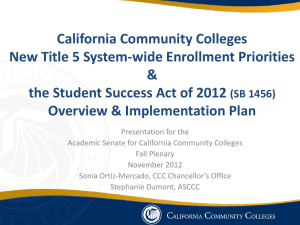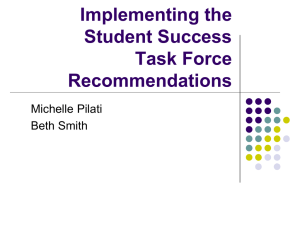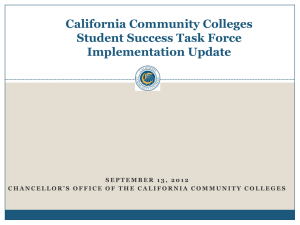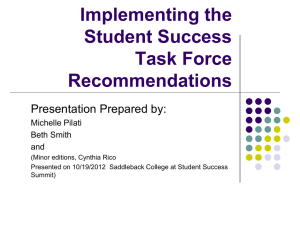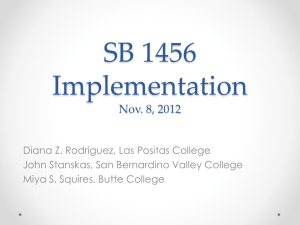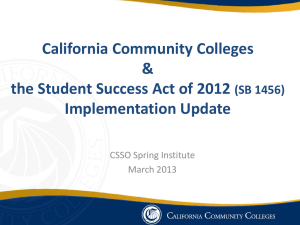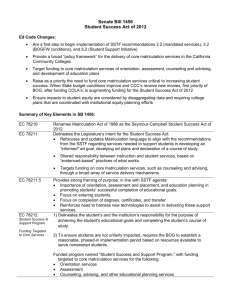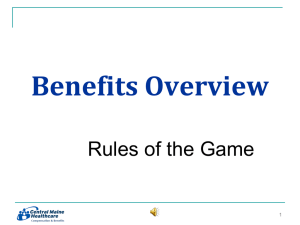Spring 2014 Flex Day Presentation
advertisement
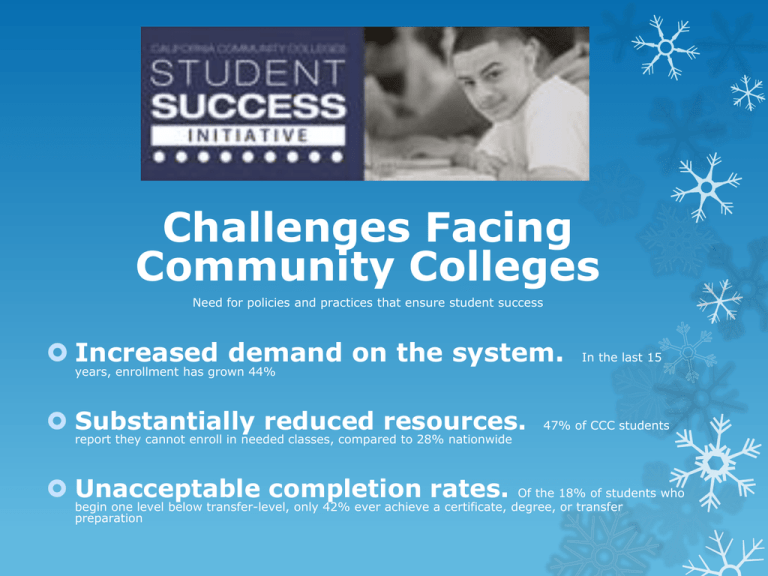
Challenges Facing Community Colleges Need for policies and practices that ensure student success Increased demand on the system. years, enrollment has grown 44% Substantially reduced resources. report they cannot enroll in needed classes, compared to 28% nationwide Unacceptable completion rates. In the last 15 47% of CCC students Of the 18% of students who begin one level below transfer-level, only 42% ever achieve a certificate, degree, or transfer preparation Taking Action Now Creation of the Student Success Task Force Pursuant to Senate Bill 1143, the California Community Colleges Board of Governors (BOG) established the Student Success Task Force The Task Force Goal was to examine best practices and models for accomplishing student success and present recommendations The Task Force was composed of 20 members from a diverse group of internal and external stakeholders Refocusing California Community Colleges toward student success This comprehensive plan to improve the System’s capacity to serve students: Would rebalance priorities within the community college system to better focus on the core missions of workforce preparation and transfer, while protecting access Would make community colleges more responsive to the needs of students and the economy Would increase student success rates for certificate and degree completion and transfer to four-year institutions Recommendations Overview 8 areas of focus with 22 recommendations 1. Increase college and career readiness 2. Strengthen support for entering students 3. Incentivize successful student behaviors 4. Align course offerings to meet student needs 5. Improve education of basic skills students 6. Revitalize and re-envision professional development 7. Enable efficient statewide leadership and increase coordination among colleges 8. Align resources with student success recommendations Key Momentum Points Successful completion of first 30 semester units Successful completion of first 15 semester units Successful completion of first collegiate level mathematics course Successful course completion & Successful completion of basic skills preparation Certificate, Degree, and/or Transfer The SSTF Recommendations & SB 1456 First step to begin implementation of SSTF recommendations: 2.2 (mandated services), 2.3 Centralized and integrated technology 2.5 Declare program of study 3.1 Priority Enrollment 3.2 (BOGFW conditions), and 8.2 (Student Support Initiative) Student Success Task Force Recommendation 8.2: Student Success Initiative A.K.A. Student Success Act of 2012 (SB 1456) Formally known as Matriculation Signed by Governor Brown on September 27, 2012 & Effective January 1, 2013 SB 1456: the Student Success Act of 2012 Provides a “policy framework” •Delineates the Legislature’s intent for the Student Success Act: •Aligns matriculation language to SSTF recommendations regarding services needed to support students in developing an “informed” ed. goal, developing ed. plans and declaration of course of study. •Shared responsibility between instruction and student services, based on “evidenced-based” practices of what works. •Targets funding on core services through a broad array of service delivery mechanisms (including technology). •Requires Board of Governors to adopt policies to mandate orientation, assessment, and student educational plans, along with an exemption and appeals process. •The BOG to establish a reasonable, phased-in implementation period based on resources available to serve students. Student Success and Support Program Scope and Intent …Student Success is the responsibility of the institution and student, supported by well-coordinated and evidence based student and instructional services to foster academic success. Title 5, Section 55500 Matriculation Then & Now… 8 funded components 3 funded core services: orientation, assessment, counseling/advising/other student education planning Colleges required to provide core matriculation services, but students not required to complete them Institutional AND student requirements Incentivizes student completion of core services Stand-alone program planning Funding allocated based on enrollment data for new and continuing students Incomplete data reporting on matriculation services Clear link to student equity planning SSTF and BOG priority in restoration of matriculation funds Funding formula to include services provided as one element Linked to ARCC 2.0 Scorecard Focus Area 2: Strengthen Support for Entering Students Recommendation 2.2: Require all incoming community college students to: 1. participate in diagnostic assessment and orientation and, 2. develop an educational plan Student Success and Support Program Core Services Orientation: A process that acquaints students and potential students with, at a minimum, college programs, student support services, facilities and grounds, academic expectations, institutional procedures, and other appropriate information… Title 5, Section 55521 Student Success and Support Program Core Services Assessment for Placement: The process of gathering information about … the student's study skills, English language proficiency, computational skills, aptitudes, goals, learning skills, career aspirations, academic performance, and need for special services. Assessment methods may include, but not necessarily be limited to, interviews, standardized tests, attitude surveys, vocational or career aptitude and interest inventories, high school or postsecondary transcripts, specialized certificates or licenses, educational histories, and other measures of performance. Education Code section 78213 Student Success and Support Program Core Services Counseling, Advising, Other Education Planning Services: All first-time students expected to have: Abbreviated Ed Plan is 1-2 semesters in length - or - Comprehensive Ed Plan …take(s) into account a student’s interests, skills, career and education goals, major, potential transfer institutions, and the steps the student needs to take…to complete their identified course of study. Title 5 Section 55524 Student Success and Support Program Core Services Student Follow-up: Required for at-risk students Enrolled in Basic Skills courses Have not identified an education goal and course of study Are on Academic or Progress Probation – at risk of losing enrollment priority and BOG Fee Waiver Focus Area 2: Strengthen Support for Entering Students Recommendation 2.3: Community colleges will develop and use centralized and integrated technology, which can be accessed through campus or district web portals, to better guide students in their educational process. CCCApply E-Transcripts Online BOG FW Student Planning Benefits for our students: One single application statewide – saves information if apply to new college Spanish version available Better statewide data collection Online BOG Fee Waiver Benefits: Online ordering of transcripts & enrollment verification Faster processing time for e-transcripts Automatic messaging when services are complete Electronic delivery for more efficiency Report functions Top Recipients 20 18 16 14 12 10 8 6 4 2 0 CALIFORNIA STATE UNIVERSITY, STANISLAUS WESTERN GOVERNORS UNIVERSITY CALIFORNIA STATE UNIVERSITY SACRAMENTO CSU STANISLAUS CALIFORNIA STATE UNIVERSITY STANISLAUS Student Planning Benefits: Student access to their progress (Degree Audit) Online semester planning linked to class schedule Focus Area 2: Strengthen Support for Entering Students Recommendation 2.5: Encourage students to declare a program of study upon admission, intervene if a declaration is not made by the end of their second term, and require declaration by the end of their third term in order to maintain enrollment priority. Focus Area 3: Incentivize Successful Behaviors Recommendation 3.1: The community colleges will adopt system-wide enrollment priorities that: 1. reflect the core mission of transfer, career technical education and basic skills development; 2. encourage students to identify their educational objective and follow a prescribed path most likely to lead to success; 3. ensure access and the opportunity for success for new students; and 4. incentivize students to make progress toward their educational goal. Priority Enrollment Concept in the Proposed Title 5, Section 58108 Regulation Order of Priority: Academic Conditions for : •100 unit threshold •Good standing: not on academic or progress probation for 2 consecutive terms (title 5, 55031) 1 Ed Code: Active duty military & veteran students* and current and former foster youth* who are new & fully matriculated or continuing in good standing 2 Existing Title 5: New and continuing fully matriculated EOPS & DSPS students in good standing 3 Continuing students in good standing and new, fully matriculated students. District flexibility to set priorities and categories for other students District flexibility provided to collapse level 1 & 2 if sufficient capacity exists to do so without displacing level 1 students District flexibility to set priorities and categories within these groups *Education Code section 66025.8 requires community college to grant priority enrollment to any member or former member of the Armed Forces of the United States within four years of leaving active duty. EC 66025.9 requires priority enrollment for current and former foster youth up to, and including, age 24. Loss of Enrollment Priority Continuing students would lose enrollment priority if they… • Earned more than 100 units (not including nondegree applicable basic skills and ESL, and special classes) • Are on academic or progress probation for two consecutive terms (as defined by existing title 5 regulations) Exemptions & Appeals • Exemptions: Districts may exempt categories of students or units from the 100 unit limit. For example: • High unit majors or programs • Units earned through credit by exam, Advanced Placement, IB, etc… • Appeals: Districts must adopt an appeals policy and process for students who: 1. Lose enrollment priority due to extenuating circumstances 2. Are disabled and who applied for but did not receive timely reasonable accommodation 3. Districts may also allow appeals for students who demonstrate “significant academic improvement” in a subsequent term Focus Area 3: Incentivize Successful Behaviors Recommendation 3.2: Require students receiving Board of Governors (BOG) Fee Waivers to meet various conditions and requirements: (A) Identify a degree, certificate, transfer, or career advancement goal; (B) Meet institutional satisfactory progress standards to be eligible for fee waiver renewal; and (C) Have a transcript that reflects no more than 110 units, not including basic skills and ESL courses. SB 1456 and the BOG Fee Waiver Will mirror Enrollment Priority regulations: Rely on existing academic (2.0) and progress (50%) standards in 55031(a) and (b) Loss of fee waiver eligibility after two consecutive terms on probation (some discussion needed about how to treat summer terms) Single appeal process for loss of enrollment priority and loss of BOGFW Possible Timeline for Fee Waiver Regulations Proposed regulations to Board of Governors (BOG) May, 2013 Adoption of regulations by (BOG) July, 2013 Begin consumer information dissemination and notification 2013-14 and 2014-15 – first official notification after spring 2014 Make system changes during 2014-15 to allow for single term fee waiver award First loss of fee waiver anticipated fall 2015 – districts may not implement early Focus Area 8: Align Resources with Student Success Recommendations Recommendation 8.2: Invest in a student support initiative Funding Formula for 2013-14 and 2014-15 Allocations based on existing Matriculation formula: 2.4 X new credit students plus 1.0 X continuing credit students Each college receives at least 95% of prior year’s credit allocation (if budget allows) Minimum guaranteed base allocation of $50,000 for small colleges Credit enrollment headcount based on prior year MIS data Match requirement of 3:1 SB 1456 Student Success and Support Program Credit Funding Formula College’s Potential Population of Students to Receive Services Students Served at the College Initial Orientation (SS06)** 10% Unduplicated Credit Student Headcount* Base Funding Floor $35K or 10% Initial Assessment (SS07)** 10% (academic year = summer, fall, winter, spring) (whichever is greater) Abbreviated SEP (SS09)** 10% College Match 3:1*** Counseling/Advising (SS08) 15% Comprehensive SEP (SS09) 35% At Risk Follow-Up Svc (SM10) 15% 40% *Includes CA resident students enrolled as of census in at least 0.5 credit units, (STD7) headcount status “A,” “B,” “C,” excludes special admits Other Follow-Up Svc (SM11) 5% 60% **Include pre-enrollment services provided for students with SB record ***Match may include A&R, & SSSP related technology & research Student Success Act of 2012 (SB 1456) Student Success & Support Program Implementation Timeline Fiscal Year 2012-2013 System-level Planning Year: • • • Fiscal Year 2013-2014 District/College-Level Implementation Planning Year: workgroups • Develop program plans convened October • Implement MIS changes 2012 to develop & ensure accurate & proposals for title 5 complete data reporting Matriculation • Funding targeted to core revisions, new services of orientation, allocation formula, & assessment, counseling revised MIS data & advising, & other elements & education planning definitions services New program • Allocations remain planning & budget consistent as prior year, process developed new formula not applied SB 1456 effective (95% guarantee) January 1, 2013 Complete Fiscal Year 2014-2015 District/College-Level Implementation Year 1: • Program plans & budgets submitted • Continue to ensure accurate & complete data reporting • Legislative implementation report due July 1, 2014 (biannually thereafter) • Proposed student notification requirement Spring 2015 • Allocations remain consistent as prior year, new formula not applied (95% guarantee) Fiscal Year 2015-2016 Implementation Year 2: • FY 15-16 allocations based on 14-15 yearend data reported • Fall 2015: Proposed requirement of mandated services for first time students • Application of funding formula beginning this year (80% guarantee) Fiscal Year 2016-2017 Implementation Year 3: • Legislative report due July 1, 2016 • FY 16-17 allocations based on 1516 year-end data reported (50% guarantee) Summary of Student Impact Required assessment, orientation & advisement Required declaration of program of student Required Educational Plan New priority registration rules Fully Matriculated Good Academic Standing Less than 100 units New BOGFW restrictions Closing Thoughts… As we implement policy changes … Keep the dialogue focused on what works for students Think about how can we incentivize student and institutional behaviors to increase student success Be mindful of equity impacts… need to track student outcomes- especially for underrepresented and educationally disadvantaged student groups… College-wide Efforts! So Now What? SSSP workgroup to determine: Examine orientation, assessment, counseling/SEP Considerations: sequence of delivery, scalability, increasing access, methodologies, use of technology IT interfacing considerations Scheduling software (SARS) and student record system (Datatel) MIS redesign implementation plan Want to help or just want more information? Chancellor’s Office website: www.cccco.edu Flex Day Breakout sessions: Friday, Jan 10, 10:45 am Orientation & Assessment Education Planning Academic Follow-Up Feedback: questions, comments, suggestions Index cards Survey Monkey Columbia College SSSP workgroup Columbia’s SSSP Workgroup Melissa Raby John Leamy Chris Vitelli Elizabeth Pfleging Randy Barton Courtney Castle Diana Sunday Rick Rivera Colleen Henry Adrienne Seegers Shawn Jordison Tina Troiler Matt Christman Karin Rodts
